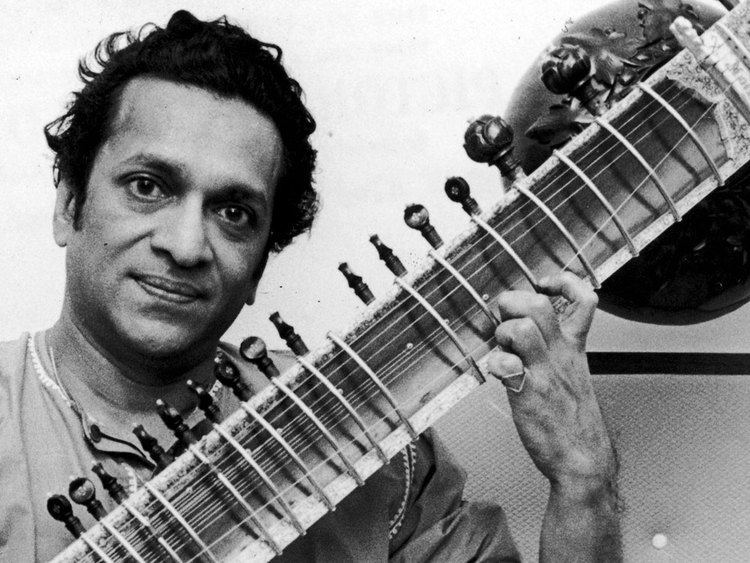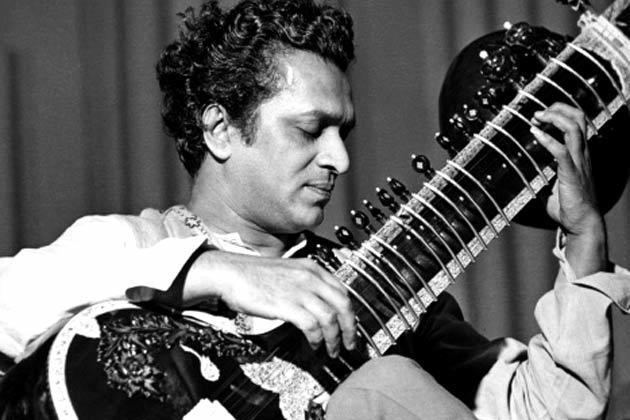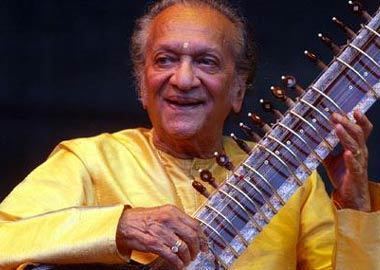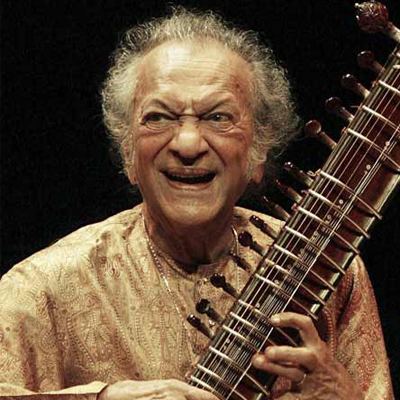Genres Hindustani classical Occupation(s) Musiciancomposer Name Ravi Shankar | Instruments Sitarvocals Role Musician Years active 1939–2012 | |
 | ||
Birth name Robindro Shaunkor Chowdhuryরবীন্দ্র শঙ্কর চৌধুরী Born 7 April 1920Benares, India ( 1920-04-07 ) Children Anoushka Shankar, Norah Jones, Shubhendra Shankar Albums Chants of India, The Concert for Bangladesh, Passages, Collaborations, In Concert 1972 | ||
Biography sr ravi shankar godfather of world music
Ravi Shankar, KBE ([ˈrɔbi ˈʃɔŋkɔr]; 7 April 1920 – 11 December 2012), born Rabindra Shankar Chowdhury, his name often preceded by the title Pandit ('Master'), was a Bengali Indian musician and a composer of Hindustani classical music. He was one of the best-known exponents of the sitar in the second half of the 20th century and influenced many other musicians throughout the world.
Contents
- Biography sr ravi shankar godfather of world music
- Ravi shankar woodstock 1969 evening raga
- Early life
- Training and work in India
- 195669 International performances
- 19702012 International performances
- Collaboration with George Harrison
- Style and contributions
- Indian governmental honours
- Other governmental and academic honours
- Arts awards
- Other honours and tributes
- Personal life and family
- Illness and death
- Books
- References

Shankar was born to a Bengali family in India, and spent his youth touring India and Europe with the dance group of his brother Uday Shankar. He gave up dancing in 1938 to study sitar playing under court musician Allauddin Khan. After finishing his studies in 1944, Shankar worked as a composer, creating the music for the Apu Trilogy by Satyajit Ray, and was music director of All India Radio, New Delhi, from 1949 to 1956.

In 1956 he began to tour Europe and the Americas playing Indian classical music and increased its popularity there in the 1960s through teaching, performance, and his association with violinist Yehudi Menuhin and Beatles guitarist George Harrison. His influence on the latter helped popularize the use of Indian instruments in pop music throughout the 1960s. Shankar engaged Western music by writing compositions for sitar and orchestra, and toured the world in the 1970s and 1980s. From 1986 to 1992, he served as a nominated member of Rajya Sabha, the upper chamber of the Parliament of India. He continued to perform until the end of his life. In 1999, Shankar was awarded India's highest civilian honour, the Bharat Ratna.

Ravi shankar woodstock 1969 evening raga
Early life
Shankar was born on 7 April 1920 in Benares, British India, in a Bengali family, as the youngest of seven brothers. His father, Shyam Shankar Chowdhury, was a Middle Temple barrister and scholar from East Bengal (now Bangladesh). A respected statesman, lawyer and politician, he served for several years as dewan (Prime minister) of Jhalawar, Rajasthan, and used the Sanskrit spelling of the family name and removed its last part. Shyam was married to Hemangini Devi who hailed from a small village named Nasrathpur in Mardah block of Ghazipur district, near Benares and her father was a prosperous landlord. Shyam later worked as a lawyer in London, England, and there he married a second time while Devi raised Shankar in Benares, and did not meet his son until he was eight years old. Shankar shortened the Sanskrit version of his first name, Ravindra, to Ravi, for "sun". Shankar had six siblings, only four of whom lived past infancy: Uday (who became a famous choreographer and dancer), Rajendra, Debendra and Bhupendra. Shankar attended the Bengalitola High School in Benares between 1927 and 1928.
At the age of ten, after spending his first decade in Benares, Shankar went to Paris with the dance group of his brother, choreographer Uday Shankar. By the age of 13 he had become a member of the group, accompanied its members on tour and learned to dance and play various Indian instruments. Uday's dance group toured Europe and the United States in the early to mid-1930s and Shankar learned French, discovered Western classical music, jazz, cinema and became acquainted with Western customs. Shankar heard Allauddin Khan – the lead musician at the court of the princely state of Maihar – play at a music conference in December 1934 in Calcutta, and Uday convinced the Maharaja of Maihar in 1935 to allow Khan to become his group's soloist for a tour of Europe. Shankar was sporadically trained by Khan on tour, and Khan offered Shankar training to become a serious musician under the condition that he abandon touring and come to Maihar.
Training and work in India
Shankar's parents had died by the time he returned from the European tour, and touring the West had become difficult because of political conflicts that would lead to World War II. Shankar gave up his dancing career in 1938 to go to Maihar and study Indian classical music as Khan's pupil, living with his family in the traditional gurukul system. Khan was a rigorous teacher and Shankar had training on sitar and surbahar, learned ragas and the musical styles dhrupad, dhamar, and khyal, and was taught the techniques of the instruments rudra veena, rubab, and sursingar. He often studied with Khan's children Ali Akbar Khan and Annapurna Devi. Shankar began to perform publicly on sitar in December 1939 and his debut performance was a jugalbandi (duet) with Ali Akbar Khan, who played the string instrument sarod.
Shankar completed his training in 1944. He moved to Mumbai and joined the Indian People's Theatre Association, for whom he composed music for ballets in 1945 and 1946. Shankar recomposed the music for the popular song "Sare Jahan Se Achcha" at the age of 25. He began to record music for HMV India and worked as a music director for All India Radio (AIR), New Delhi, from February 1949 to January 1956. Shankar founded the Indian National Orchestra at AIR and composed for it; in his compositions he combined Western and classical Indian instrumentation. Beginning in the mid-1950s he composed the music for the Apu Trilogy by Satyajit Ray, which became internationally acclaimed. He was music director for several Hindi movies including Godaan and Anuradha.
1956–69: International performances
V. K. Narayana Menon, director of AIR Delhi, introduced the Western violinist Yehudi Menuhin to Shankar during Menuhin's first visit to India in 1952. Shankar had performed as part of a cultural delegation in the Soviet Union in 1954 and Menuhin invited Shankar in 1955 to perform in New York City for a demonstration of Indian classical music, sponsored by the Ford Foundation.
Shankar heard about the positive response Khan received and resigned from AIR in 1956 to tour the United Kingdom, Germany, and the United States. He played for smaller audiences and educated them about Indian music, incorporating ragas from the South Indian Carnatic music in his performances, and recorded his first LP album Three Ragas in London, released in 1956. In 1958, Shankar participated in the celebrations of the tenth anniversary of the United Nations and UNESCO music festival in Paris. From 1961, he toured Europe, the United States, and Australia, and became the first Indian to compose music for non-Indian films. Shankar founded the Kinnara School of Music in Mumbai in 1962.
Shankar befriended Richard Bock, founder of World Pacific Records, on his first American tour and recorded most of his albums in the 1950s and 1960s for Bock's label. The Byrds recorded at the same studio and heard Shankar's music, which led them to incorporate some of its elements in theirs, introducing the genre to their friend George Harrison of the Beatles.
In 1967, Shankar performed a well-received set at the Monterey Pop Festival. While complimentary of the talents of several of the rock artists at the festival, he said he was "horrified" to see Jimi Hendrix set fire to his guitar on stage: "That was too much for me. In our culture, we have such respect for musical instruments, they are like part of God." Shankar's live album from Monterey peaked at number 43 on Billboard's pop LPs chart in the US, which remains the highest placing he achieved on that chart.
Shankar won a Grammy Award for Best Chamber Music Performance for West Meets East, a collaboration with Yehudi Menuhin. He opened a Western branch of the Kinnara School of Music in Los Angeles, in May 1967, and published an autobiography, My Music, My Life, in 1968. In 1968, he composed the score for the film Charly.
He performed at the Woodstock Festival in August 1969, and found he disliked the venue. In the late 1960s Shankar distanced himself from the hippie movement and drug culture: He explained during an interview:
It makes me feel rather hurt when I see the association of drugs with our music. The music to us is religion. The quickest way to reach godliness is through music. I don't like the association of one bad thing with the music.
1970–2012: International performances
In October 1970 Shankar became chair of the department of Indian music of the California Institute of the Arts after previously teaching at the City College of New York, the University of California, Los Angeles, and being guest lecturer at other colleges and universities, including the Ali Akbar College of Music. In late 1970, the London Symphony Orchestra invited Shankar to compose a concerto with sitar. Concerto for Sitar & Orchestra was performed with André Previn as conductor and Shankar playing the sitar. Shankar performed at the Concert for Bangladesh in August 1971, held at Madison Square Garden in New York. After the musicians had tuned up on stage for over a minute, the crowd of rock-music fans broke into applause, to which the amused Shankar responded: "If you like our tuning so much, I hope you will enjoy the playing more." Although interest in Indian music had decreased in the early 1970s, the live album from the concert became one of the best-selling recordings to feature the genre and won Shankar a second Grammy Award.
Shankar's demanding tour schedule weakened his health, and he suffered a heart attack in Chicago in November 1974, causing him to miss a portion of the tour. The touring band visited the White House on invitation of John Gardner Ford, son of US President Gerald Ford. Shankar toured and taught for the remainder of the 1970s and the 1980s and released his second concerto, Raga Mala, conducted by Zubin Mehta, in 1981. Shankar was nominated for an Academy Award for Best Original Music Score for his work on the 1982 movie Gandhi.
He performed in Moscow in 1988, and had first been there to play in 1954. His 1988 concert was performed with 140 musicians, including the Russian Folk Ensemble and members of the Moscow Philharmonic, along with his own group of Indian musicians.
He served as a member of the Rajya Sabha, the upper chamber of the Parliament of India, from 12 May 1986 to 11 May 1992, after being nominated by Indian Prime Minister Rajiv Gandhi. Shankar composed the dance drama Ghanashyam in 1989. His liberal views on musical co-operation led him to contemporary composer Philip Glass, with whom he released an album, Passages, in 1990.
Because of the positive response to Shankar's 1996 career compilation In Celebration, Shankar wrote a second autobiography, Raga Mala. He performed in between 25 and 40 concerts every year during the late 1990s. Shankar taught his daughter Anoushka Shankar to play sitar and in 1997 became a Regents' Professor at University of California, San Diego.
He performed with Anoushka for the BBC in 1997 at the Symphony Hall, Birmingham England. In the 2000s, he won a Grammy Award for Best World Music Album for Full Circle: Carnegie Hall 2000 and toured with Anoushka, who released a book about her father, Bapi: Love of My Life, in 2002. After Harrison's death in 2001, Mr. Shankar performed at the Concert for George, a celebration of Harrison's music staged at the Royal Albert Hall in London in 2002.
In June 2008, Shankar played what was billed as his last European concert, but his 2011 tour included dates in the United Kingdom.
On 1 July 2010, at the Southbank Centre's Royal Festival Hall, London, England, Anoushka Shankar, on sitar, performed with the London Philharmonic Orchestra, conducted by David Murphy what was billed the first Symphony by Ravi Shankar.
Collaboration with George Harrison
Beatles guitarist George Harrison, who was first introduced to Shankar's music by American singers Roger McGuinn and David Crosby, who were big fans of Shankar, became influenced by Shankar's music. He went on to help popularize Shankar and use of Indian instruments in pop music throughout the 1960s. Olivia Harrison explains:
When George heard Indian music, that really was the trigger, it was like a bell that went off in his head. It not only awakened a desire to hear more music, but also to understand what was going on in Indian philosophy. It was a unique diversion.
Harrison became interested in Indian classical music, bought a sitar and used it to record the song "Norwegian Wood (This Bird Has Flown)". In 1968 he went to India to take lessons from Shankar, some of which were captured on video. This led to Indian music being used by other musicians and created the raga rock trend. As the sitar and Indian music grew in popularity, groups such as The Rolling Stones, The Animals and The Byrds began using it in some of their songs. The influence even extended to blues musicians such as Michael Bloomfield, who created a raga-influenced improvisation number, "East-West" (Bloomfield scholars have cited its working title as "The Raga" when Bloomfield and his collaborator Nick Gravenites began to develop the idea) for the Butterfield Blues Band in 1966.
Harrison met Shankar in London in June 1966 and visited India later that year for six weeks to study sitar under Shankar in Srinagar. During the visit, a documentary film about Shankar named Raga was shot by Howard Worth, and released in 1971. Shankar's association with Harrison greatly increased Shankar's popularity and Ken Hunt of AllMusic would state that Shankar had become "the most famous Indian musician on the planet" by 1966.
George Harrison organized the charity Concert for Bangladesh in August 1971, in which Shankar participated. During the 1970s, Shankar and Harrison worked together again, recording Shankar Family & Friends in 1973 and touring North America the following year to a mixed response after Shankar had toured Europe with the Harrison-sponsored Music Festival from India. Shankar wrote a second autobiography, Raga Mala, with Harrison as editor.
Style and contributions
Shankar developed a style distinct from that of his contemporaries and incorporated influences from rhythm practices of Carnatic music. His performances begin with solo alap, jor, and jhala (introduction and performances with pulse and rapid pulse) influenced by the slow and serious dhrupad genre, followed by a section with tabla accompaniment featuring compositions associated with the prevalent khyal style. Shankar often closed his performances with a piece inspired by the light-classical thumri genre.
Shankar has been considered one of the top sitar players of the second half of the 20th century. He popularised performing on the bass octave of the sitar for the alap section and became known for a distinctive playing style in the middle and high registers that used quick and short deviations of the playing string and his sound creation through stops and strikes on the main playing string. Narayana Menon of The New Grove Dictionary noted Shankar's liking for rhythmic novelties, among them the use of unconventional rhythmic cycles. Hans Neuhoff of Musik in Geschichte und Gegenwart has argued that Shankar's playing style was not widely adopted and that he was surpassed by other sitar players in the performance of melodic passages. Shankar's interplay with Alla Rakha improved appreciation for tabla playing in Hindustani classical music. Shankar promoted the jugalbandi duet concert style and claims to have introduced new ragas Tilak Shyam, Nat Bhairav and Bairagi.
Indian governmental honours
Other governmental and academic honours
Arts awards
Other honours and tributes
Personal life and family
Shankar married Allauddin Khan's daughter Annapurna Devi in 1941 and their son, Shubhendra Shankar, was born in 1942. Shankar separated from Devi during the 1940s and had a relationship with Kamala Shastri, a dancer, beginning in the late 1940s.
An affair with Sue Jones, a New York concert producer, led to the birth of Norah Jones in 1979. He separated from Shastri in 1981 and lived with Sue until 1986.
In 1989 he married Sukanya Rajan, whom he had known since the 1970s, at Chilkur Temple in Hyderabad. Their daughter Anoushka Shankar was born in 1981.
Shankar's son, Shubhendra "Shubho" Shankar, often accompanied him on tours. He could play the sitar and surbahar, but elected not to pursue a solo career. Shubhendra died of pneumonia in 1992.
Ananda Shankar, the experimental fusion musician, is his nephew.
Norah Jones became a successful musician in the 2000s, winning eight Grammy Awards in 2003. Anoushka Shankar was nominated for a Grammy Award for Best World Music Album in 2003. Anoushka and her father were both nominated for Best World Music Album at the 2013 Grammy Awards for separate albums.
Shankar was a Hindu, and a devotee of the Hindu deity, Hanuman. As well, he was an "ardent" devotee of the revered Bengali Hindu saint, Sri Anandamayi Ma. Shankar used to visit Anandamayi Ma frequently and performed for her on various occasions. Shankar wrote of his hometown, Benares (Varanasi), and his initial encounter with "Ma":
"Varanasi is the eternal abode of Lord Shiva, and one of my favorite temples is that of Lord Hanuman, the monkey god. The city is also where one of the miracles that have happened in my life took place: I met Ma Anandamayi, a great spiritual soul. Seeing the beauty of her face and mind, I became her ardent devotee. Sitting at home now in Encinitas, in Southern California, at the age of 88, surrounded by the beautiful greens, multi-colored flowers, blue sky, clean air, and the Pacific Ocean, I often reminisce about all the wonderful places I have seen in the world. I cherish the memories of Paris, New York, and a few other places. But Varanasi seems to be etched in my heart!"
In his later years, Shankar became a vegetarian. He wore a large diamond ring which he said was "manifested" by Sathya Sai Baba. He lived with Sukanya in Encinitas, California.
Shankar performed his final concert, with daughter Anoushka, on 4 November 2012 at the Terrace Theater in Long Beach, California.
Illness and death
On 6 December 2012, Shankar was admitted to Scripps Memorial Hospital in La Jolla, San Diego, California after complaining of breathing difficulties. He died on 11 December 2012 at around 16:30 PST after undergoing heart valve replacement surgery.
The Swara Samrat festival, organized on 5–6 January 2013 and dedicated to Ravi Shankar and Ali Akbar Khan, included performances by such musicians as Shivkumar Sharma, Birju Maharaj, Hariprasad Chaurasia, Zakir Hussain, and Girija Devi.
